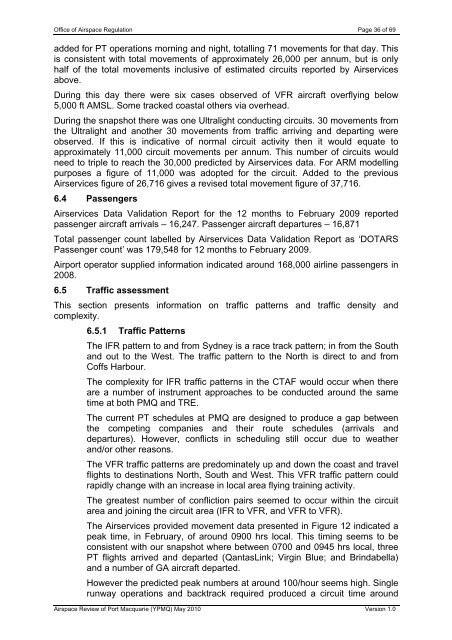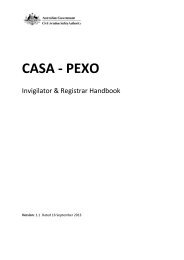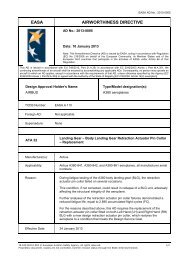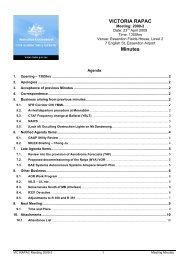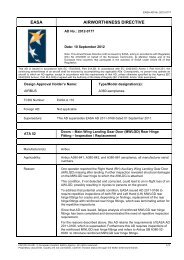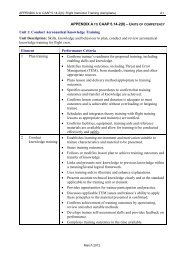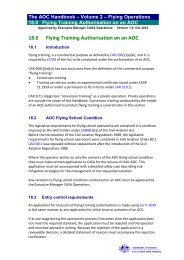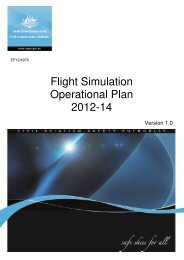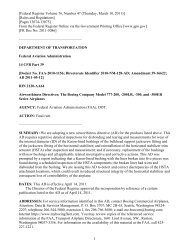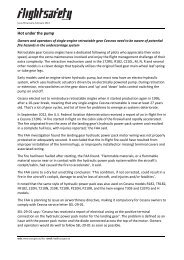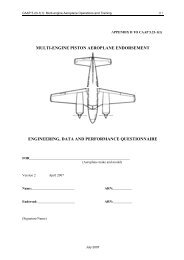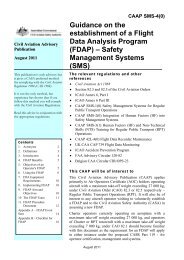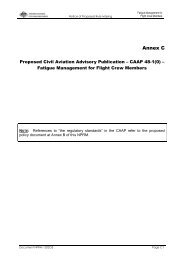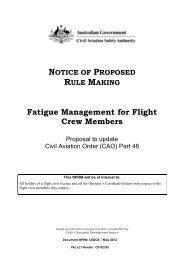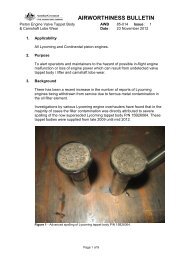Aeronautical Study of Port Macquarie - Civil Aviation Safety Authority
Aeronautical Study of Port Macquarie - Civil Aviation Safety Authority
Aeronautical Study of Port Macquarie - Civil Aviation Safety Authority
Create successful ePaper yourself
Turn your PDF publications into a flip-book with our unique Google optimized e-Paper software.
Office <strong>of</strong> Airspace Regulation Page 36 <strong>of</strong> 69<br />
added for PT operations morning and night, totalling 71 movements for that day. This<br />
is consistent with total movements <strong>of</strong> approximately 26,000 per annum, but is only<br />
half <strong>of</strong> the total movements inclusive <strong>of</strong> estimated circuits reported by Airservices<br />
above.<br />
During this day there were six cases observed <strong>of</strong> VFR aircraft overflying below<br />
5,000 ft AMSL. Some tracked coastal others via overhead.<br />
During the snapshot there was one Ultralight conducting circuits. 30 movements from<br />
the Ultralight and another 30 movements from traffic arriving and departing were<br />
observed. If this is indicative <strong>of</strong> normal circuit activity then it would equate to<br />
approximately 11,000 circuit movements per annum. This number <strong>of</strong> circuits would<br />
need to triple to reach the 30,000 predicted by Airservices data. For ARM modelling<br />
purposes a figure <strong>of</strong> 11,000 was adopted for the circuit. Added to the previous<br />
Airservices figure <strong>of</strong> 26,716 gives a revised total movement figure <strong>of</strong> 37,716.<br />
6.4 Passengers<br />
Airservices Data Validation Report for the 12 months to February 2009 reported<br />
passenger aircraft arrivals – 16,247. Passenger aircraft departures – 16,871<br />
Total passenger count labelled by Airservices Data Validation Report as ‘DOTARS<br />
Passenger count’ was 179,548 for 12 months to February 2009.<br />
Airport operator supplied information indicated around 168,000 airline passengers in<br />
2008.<br />
6.5 Traffic assessment<br />
This section presents information on traffic patterns and traffic density and<br />
complexity.<br />
6.5.1 Traffic Patterns<br />
The IFR pattern to and from Sydney is a race track pattern; in from the South<br />
and out to the West. The traffic pattern to the North is direct to and from<br />
C<strong>of</strong>fs Harbour.<br />
The complexity for IFR traffic patterns in the CTAF would occur when there<br />
are a number <strong>of</strong> instrument approaches to be conducted around the same<br />
time at both PMQ and TRE.<br />
The current PT schedules at PMQ are designed to produce a gap between<br />
the competing companies and their route schedules (arrivals and<br />
departures). However, conflicts in scheduling still occur due to weather<br />
and/or other reasons.<br />
The VFR traffic patterns are predominately up and down the coast and travel<br />
flights to destinations North, South and West. This VFR traffic pattern could<br />
rapidly change with an increase in local area flying training activity.<br />
The greatest number <strong>of</strong> confliction pairs seemed to occur within the circuit<br />
area and joining the circuit area (IFR to VFR, and VFR to VFR).<br />
The Airservices provided movement data presented in Figure 12 indicated a<br />
peak time, in February, <strong>of</strong> around 0900 hrs local. This timing seems to be<br />
consistent with our snapshot where between 0700 and 0945 hrs local, three<br />
PT flights arrived and departed (QantasLink; Virgin Blue; and Brindabella)<br />
and a number <strong>of</strong> GA aircraft departed.<br />
However the predicted peak numbers at around 100/hour seems high. Single<br />
runway operations and backtrack required produced a circuit time around<br />
Airspace Review <strong>of</strong> <strong>Port</strong> <strong>Macquarie</strong> (YPMQ) May 2010 Version 1.0


